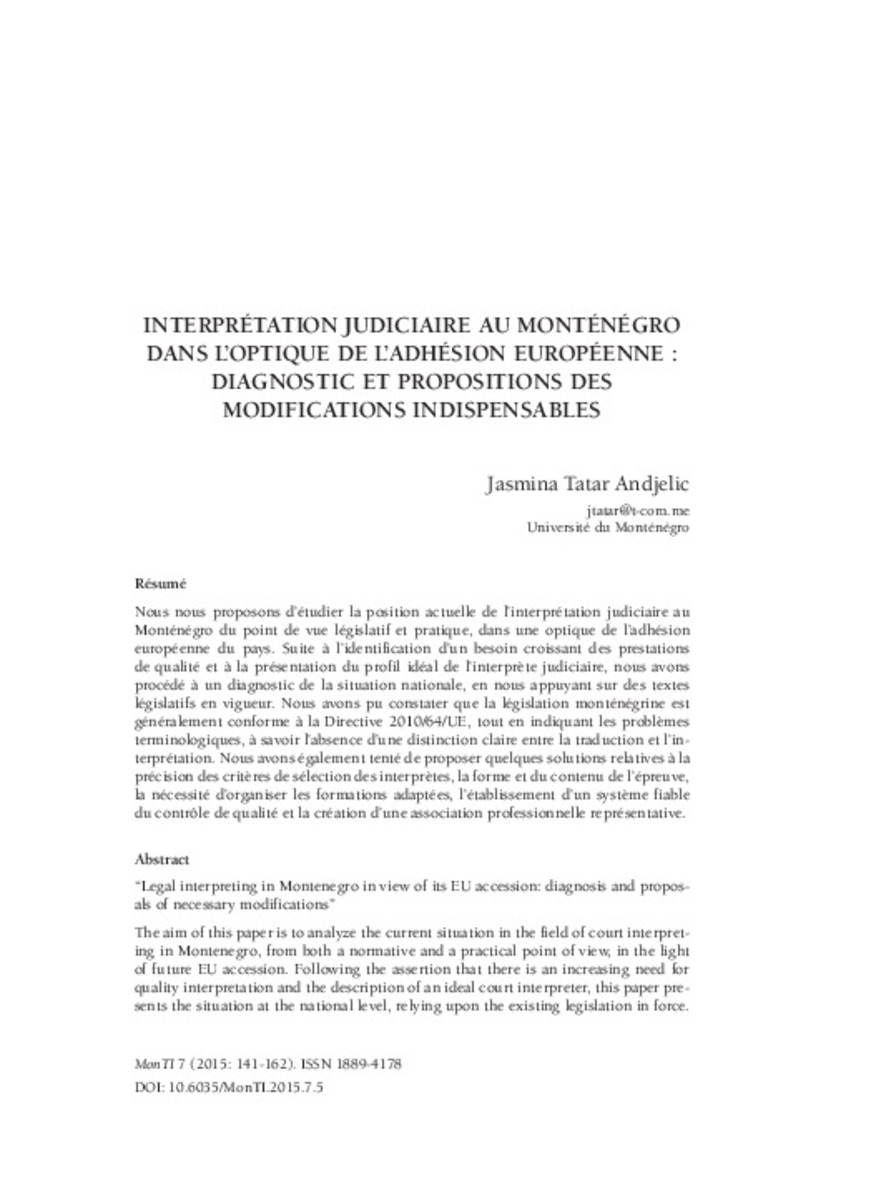Mostrar el registro sencillo del ítem
Interprétation judiciaire au Monténégro dans l’optique de l’adhésion européenne: diagnostic et propositions des modifications indispensables.
| dc.contributor.author | Andjelic, Jasmina Tatar | |
| dc.date.accessioned | 2016-02-10T08:35:26Z | |
| dc.date.available | 2016-02-10T08:35:26Z | |
| dc.date.issued | 2015 | |
| dc.identifier.issn | 1889-4178 | |
| dc.identifier.issn | 1989-9335 (electrònic) | |
| dc.identifier.uri | http://hdl.handle.net/10234/149351 | |
| dc.description.abstract | Nous nous proposons d’étudier la position actuelle de l’interprétation judiciaire au Monténégro du point de vue législatif et pratique, dans une optique de l’adhésion européenne du pays. Suite à l’identification d’un besoin croissant des prestations de qualité et à la présentation du profil idéal de l’interprète judiciaire, nous avons procédé à un diagnostic de la situation nationale, en nous appuyant sur des textes législatifs en vigueur. Nous avons pu constater que la législation monténégrine est généralement conforme à la Directive 2010/64/UE, tout en indiquant les problèmes terminologiques, à savoir l’absence d’une distinction claire entre la traduction et l’interprétation. Nous avons également tenté de proposer quelques solutions relatives à la précision des critères de sélection des interprètes, la forme et du contenu de l’épreuve, la nécessité d’organiser les formations adaptées, l’établissement d’un système fiable du contrôle de qualité et la création d’une association professionnelle représentative. | ca_CA |
| dc.description.abstract | The aim of this paper is to analyze the current situation in the field of court interpreting in Montenegro, from both a normative and a practical point of view, in the light of future EU accession. Following the assertion that there is an increasing need for quality interpretation and the description of an ideal court interpreter, this paper presents the situation at the national level, relying upon the existing legislation in force. It is noted that Montenegrin legislation is generally harmonized with the EU Directive 2010/64/EU, but there is an issue of terminology that results in an unclear distinction between interpretation and translation. This paper proposes several solutions in order to define more detailed criteria for the selection of interpreters, form and content of the exam, necessity of organizing specialized training, introduction of a reliable system of quality control and establishment of a representative professional association. | ca_CA |
| dc.format.extent | 22 p. | ca_CA |
| dc.format.mimetype | application/pdf | ca_CA |
| dc.language.iso | fra | ca_CA |
| dc.publisher | Universitat Jaume I | ca_CA |
| dc.publisher | Universitat de València | ca_CA |
| dc.publisher | Universitat d' Alacant | ca_CA |
| dc.relation.isPartOf | MonTI, 2015, núm. 7 p. 141-162 | ca_CA |
| dc.rights | © d’aquesta edició: Universitat d’Alacant, Universitat Jaume I, Universitat de València | ca_CA |
| dc.rights.uri | http://creativecommons.org/licenses/by/4.0/ | * |
| dc.subject | legal interpretation | ca_CA |
| dc.subject | court interpreting | ca_CA |
| dc.subject | translation | ca_CA |
| dc.subject | EU accession | ca_CA |
| dc.subject | interpreting skills | ca_CA |
| dc.title | Interprétation judiciaire au Monténégro dans l’optique de l’adhésion européenne: diagnostic et propositions des modifications indispensables. | ca_CA |
| dc.title.alternative | Legal interpreting in Montenegro in view of its EU accession: diagnosis and proposals of necessary modifications. | ca_CA |
| dc.type | info:eu-repo/semantics/article | ca_CA |
| dc.identifier.doi | http://dx.doi.org/10.6035/MonTI.2015.7.5 | |
| dc.rights.accessRights | info:eu-repo/semantics/openAccess | ca_CA |
| dc.relation.publisherVersion | http://hdl.handle.net/10045/52542 | ca_CA |
Ficheros en el ítem
Este ítem aparece en la(s) siguiente(s) colección(ones)
-
MonTi_ 2015 _núm 7 [14]








